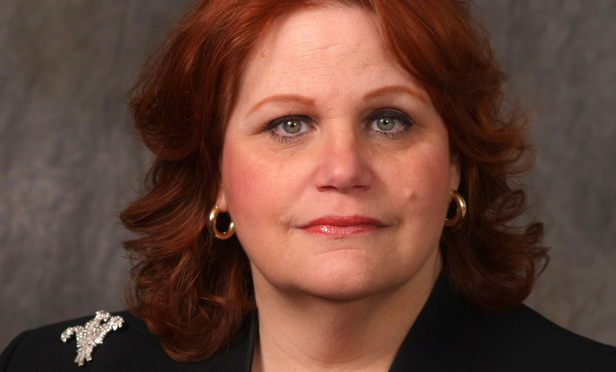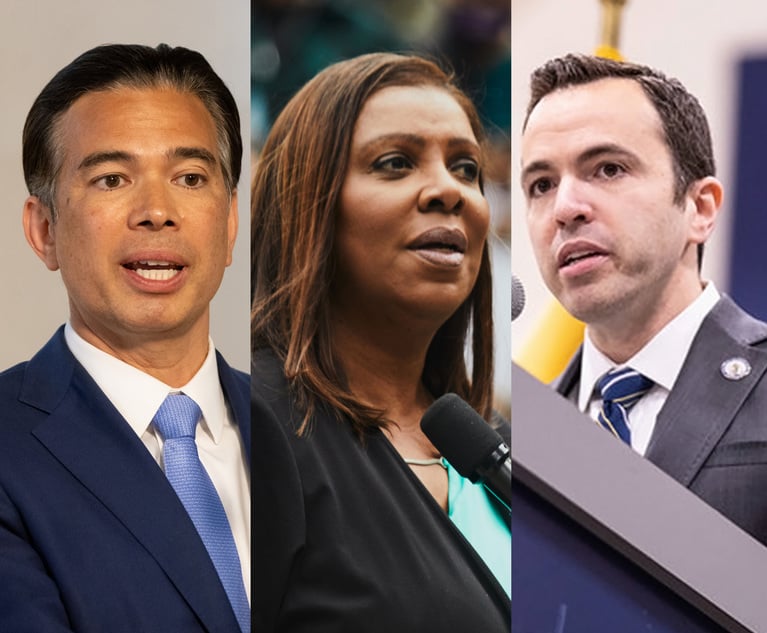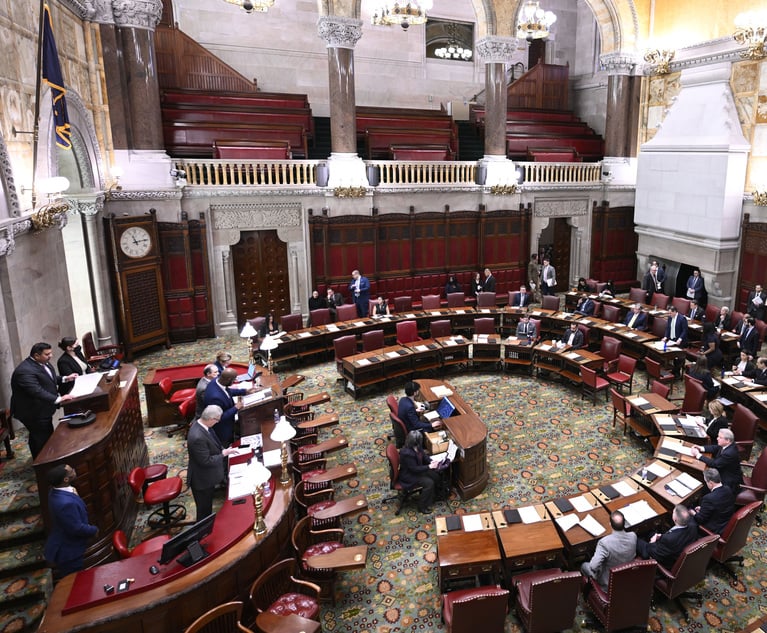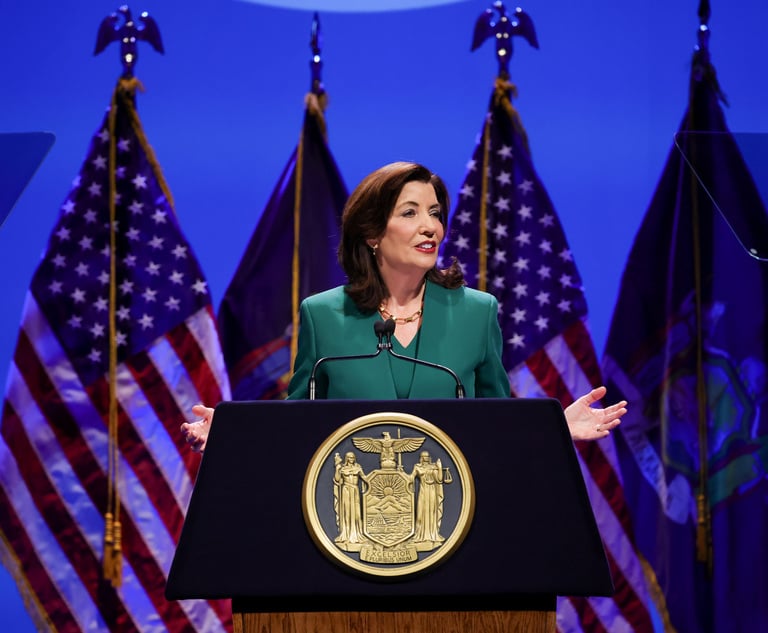NY State Regulators Certainly Are Not Climate Change Skeptics
In her State Environmental Regulation column, Charlotte A. Biblow writes: Climate Week 2019, the actions being taken by the state, and forward movement on congestion pricing all demonstrate that climate change is on the minds of many, including many in New York.
March 20, 2019 at 02:45 PM
9 minute read
 Charlotte A. Biblow
Charlotte A. Biblow
A few months from now, New York City again will be hosting a week-long series of events dealing with the climate and steps that are being taken—and that the promoters believe should be taken—to combat climate change. Climate Week NYC 2019, as it is formally known, is run by The Climate Group, an international non-profit with offices in New York City, London, and New Delhi that states on its website that its mission is “to accelerate climate action.” Climate Week, which The Climate Group coordinates with the United Nations and New York City, is an important part of what it does.
The New York State Department of Environmental Conservation (NYSDEC) also is a supporter of Climate Week. The agency has a listing for the program on its website, where it also highlights various steps that state authorities are taking in an effort to mitigate the effects of climate change.
This column discusses some of the highlights of Climate Week, scheduled to run from September 23 to September 29, and some of the steps that the state is taking in this area. It concludes with a brief update on a topic I discussed in my November 2018 column (Charlotte A. Biblow, “State (Probably) Will Bring Congestion Pricing to New York City,” NYLJ (Nov. 30, 2018)) that in many ways is related to climate change.
Climate Week NYC
In 2018, Climate Week had 150 different events. This year, The Climate Group predicts, the number of events will “far exceed” last year's and it will turn into the largest Climate Week program ever.
Government ministers, governors, mayors, and investors from around the world will be attending the opening ceremony, beginning on Monday morning, September 23, where speakers will tell about climate-related changes being made in their countries and industries. Last year, speakers included Jacinda Ardern, the prime minister of New Zealand; Martín Vizcarra, the president of Peru; Jerry Brown, then governor of California; Jake Yamashita, the chief executive officer of Ricoh Company, Ltd.; Francesco Starace, the chief executive officer and general manager of Enel SpA; and Brad Smith, Microsoft's president and chief legal officer.
For the two days that follow the opening ceremony, Climate Week 2019 has various events at which political officials and business executives will explore climate action, specifically focusing on “how to do more.” Last year, there were discussions on subjects ranging from smart buildings, transitioning to clean energy, and how to accelerate climate action to investments and climate change, the business rewards of sustainability, and climate infrastructure.
This year's Climate Week kicks off on the same day as the U.N. Secretary General's 2019 Climate Summit, which is intended to “mobilize political and economic energy … to advance climate action that will enable implementation of many of the goals of the 2030 Agenda for Sustainable Development.” The theme for this year's U.N.'s summit, “A Race We Can Win. A Race We Must Win,” is “to challenge states, regions, cities, companies, investors, and citizens to step up action in six areas: energy transition, climate finance and carbon pricing, industry transition, nature-based solutions, cities and local action, and resilience.”
The Climate Group says that the events at Climate Week NYC 2019 are going to be organized around programs reflecting the core pillars of the U.N.'s 2019 Climate Summit, including energy transition, industry, finance, cities and regional action, natural solutions, and resilience and adaptation.
Meanwhile, in New York …
With these events in mind, the various ways that the NYSDEC points out on its Climate Change website that state authorities are tackling climate change are worth highlighting.
The NYSDEC first discusses the undesirable impacts of climate change, including with respect to temperature (“the annual average temperature statewide has risen about 2.4°F since 1970, with winter warming exceeding 4.4°F”); precipitation (“average annual precipitation has increased across New York State since 1900, with year-to-year (and multiyear) variability becoming more pronounced”); sea-level rise (“Sea levels along New York's coast already have risen more than a foot since 1900” and “New York's rate of rise (about 1.2 inches per decade) is almost twice the observed global rate (0.7 inches per decade) over the same period”); and natural resources (“Spring begins a week earlier than a few decades ago,” “Winter snow cover is decreasing,” and “New York breeding bird and oceanic fish population ranges have shifted northward over the last several decades”).
The NYSDEC then notes that without an “immediate and concerted effort” to reduce greenhouse gas, temperatures will continue to increase (compared to 1971 to 2000, temperatures will be up to 3°F warmer by the 2020s, up to 6°F warmer by the 2050s, and up to 10°F warmer by the 2080s, with most warming likely to occur in the northern part of the state); average precipitation will increase (compared to 1971 to 2000, precipitation will increase up to eight percent by the 2020s, up to 12 percent by the 2050s, and up to 15 percent by the 2080s, with the biggest increases projected for the northern part of the state, in the winter months); and sea level will continue to rise (by the 2050s, by as much as 30 inches higher in New York's coastal area as compared with sea level averages for 2000 to 2004—and by up to six feet higher by 2100).
Moreover, the NYSDEC adds, climate change poses a variety of health risks as warmer temperatures increase pollen production in plants and ground-level ozone formation, exacerbating asthma, allergies, and other respiratory conditions, and as changed climate conditions increase insects and disease carriers such as mosquitoes and ticks, making West Nile virus, Lyme disease, and other diseases more prevalent “and opening the door to new pests and diseases.”
The NYSDEC then discusses a number of specific areas where state authorities are attempting to mitigate climate change, beginning with renewable energy. In this regard, the NYSDEC discusses the 2015 New York State Energy Plan, which says that renewable sources, which today provide about 11 percent of the energy we use, have the potential to meet as much as 40 percent of our energy needs by 2030. To reach this goal, the NYSDEC points out, the state is adding solar and wind “farms” and large hydroelectric power stations to supply clean renewable power on a commercial scale to New York's electric grid.
It also mentions the renewable energy incentives offered by the New York State Energy Research and Development Authority, which administers renewable energy incentives and opportunities for individuals, businesses, and institutions, among other things.
Next, the NYSDEC discusses the Regional Greenhouse Gas Initiative (RGGI), pursuant to which New York and eight other Northeastern and Middle Atlantic states seek to promote a clean-energy future with lower greenhouse gas emissions from electric power generation and savings for electricity customers. As the NYSDEC explains, the RGGI is the first mandatory market-based emissions trading program in the United States to reduce carbon dioxide emissions, and the first to use the cap-and-invest model for reducing pollution.
The NYSDEC also highlights the Climate Action Plan Interim Report, which was created by the New York State Climate Action Council following a 2009 executive order that set a goal of reducing greenhouse gas emissions in New York State by 80 percent below the levels emitted in 1990 by the year 2050. The final climate action plan is intended to assess how all economic sectors can reduce greenhouse gas emissions and adapt to climate change. The plan also must identify the extent to which such actions support New York's goals for a clean-energy economy.
Finally, the NYSDEC web page links to other clean energy programs in the state, including Charge NY (an initiative aiming to create a statewide network of up to 3,000 public and workplace charging stations and to put up to 40,000 plug-in vehicles on the road over five years); Build Smart NY (an executive order seeking to improve energy efficiency in state buildings 20 percent by 2020, by measuring building energy performance in all state buildings larger than 20,000 square feet and targeting the largest and poorest performing buildings for energy audits, efficiency upgrades, and best operations and maintenance practices); and NY Sun (a public-private partnership intended to drive growth in the solar industry and make solar technology more affordable for New Yorkers).
More on Congestion Pricing
As noted above, last November, this column suggested that the state is probably going to bring congestion pricing to New York City. That appears even more likely to come true now that New York City Mayor Bill de Blasio has thrown his support behind the idea.
Late last month, the mayor and Gov. Andrew M. Cuomo issued a joint statement endorsing congestion pricing. According to the statement (“Mayor de Blasio and Governor Cuomo Announce 10 Point Plan to Transform and Fund the MTA,” Press Release, Feb. 26, 2019), electronic tolling devices would be installed on the perimeter of the Central Business District, defined as streets south of 61st Street in Manhattan, excluding the FDR Drive. Tolls would be variable, providing discounts for off-peak hour travel, with exemptions for emergency vehicles and other exemptions or discounts for certain other groups. The announcement said that the amount of tolls would be set by December 2020, when the electronic infrastructure is expected to be in place and a capital plan finalized.
Conclusion
Climate Week 2019, the actions being taken by the state, and forward movement on congestion pricing all demonstrate that climate change is on the minds of many, including many in New York. These steps are being adopted in an effort to literally stem the tide. The extent to which they will succeed or be implemented remains to be seen.
Charlotte A. Biblow, a partner in the environmental, land use and municipal law and litigation departments of Farrell Fritz, can be reached at [email protected].
This content has been archived. It is available through our partners, LexisNexis® and Bloomberg Law.
To view this content, please continue to their sites.
Not a Lexis Subscriber?
Subscribe Now
Not a Bloomberg Law Subscriber?
Subscribe Now
NOT FOR REPRINT
© 2025 ALM Global, LLC, All Rights Reserved. Request academic re-use from www.copyright.com. All other uses, submit a request to [email protected]. For more information visit Asset & Logo Licensing.
You Might Like
View All

Federal Judge Pauses Trump Funding Freeze as Democratic AGs Plan Suit
4 minute read
Relaxing Penalties on Discovery Noncompliance Allows Criminal Cases to Get Decided on Merit
5 minute read
Bipartisan Lawmakers to Hochul Urge Greater Student Loan Forgiveness for Public-Interest Lawyers
Trending Stories
- 1Uber Files RICO Suit Against Plaintiff-Side Firms Alleging Fraudulent Injury Claims
- 2The Law Firm Disrupted: Scrutinizing the Elephant More Than the Mouse
- 3Inherent Diminished Value Damages Unavailable to 3rd-Party Claimants, Court Says
- 4Pa. Defense Firm Sued by Client Over Ex-Eagles Player's $43.5M Med Mal Win
- 5Losses Mount at Morris Manning, but Departing Ex-Chair Stays Bullish About His Old Firm's Future
Who Got The Work
J. Brugh Lower of Gibbons has entered an appearance for industrial equipment supplier Devco Corporation in a pending trademark infringement lawsuit. The suit, accusing the defendant of selling knock-off Graco products, was filed Dec. 18 in New Jersey District Court by Rivkin Radler on behalf of Graco Inc. and Graco Minnesota. The case, assigned to U.S. District Judge Zahid N. Quraishi, is 3:24-cv-11294, Graco Inc. et al v. Devco Corporation.
Who Got The Work
Rebecca Maller-Stein and Kent A. Yalowitz of Arnold & Porter Kaye Scholer have entered their appearances for Hanaco Venture Capital and its executives, Lior Prosor and David Frankel, in a pending securities lawsuit. The action, filed on Dec. 24 in New York Southern District Court by Zell, Aron & Co. on behalf of Goldeneye Advisors, accuses the defendants of negligently and fraudulently managing the plaintiff's $1 million investment. The case, assigned to U.S. District Judge Vernon S. Broderick, is 1:24-cv-09918, Goldeneye Advisors, LLC v. Hanaco Venture Capital, Ltd. et al.
Who Got The Work
Attorneys from A&O Shearman has stepped in as defense counsel for Toronto-Dominion Bank and other defendants in a pending securities class action. The suit, filed Dec. 11 in New York Southern District Court by Bleichmar Fonti & Auld, accuses the defendants of concealing the bank's 'pervasive' deficiencies in regards to its compliance with the Bank Secrecy Act and the quality of its anti-money laundering controls. The case, assigned to U.S. District Judge Arun Subramanian, is 1:24-cv-09445, Gonzalez v. The Toronto-Dominion Bank et al.
Who Got The Work
Crown Castle International, a Pennsylvania company providing shared communications infrastructure, has turned to Luke D. Wolf of Gordon Rees Scully Mansukhani to fend off a pending breach-of-contract lawsuit. The court action, filed Nov. 25 in Michigan Eastern District Court by Hooper Hathaway PC on behalf of The Town Residences LLC, accuses Crown Castle of failing to transfer approximately $30,000 in utility payments from T-Mobile in breach of a roof-top lease and assignment agreement. The case, assigned to U.S. District Judge Susan K. Declercq, is 2:24-cv-13131, The Town Residences LLC v. T-Mobile US, Inc. et al.
Who Got The Work
Wilfred P. Coronato and Daniel M. Schwartz of McCarter & English have stepped in as defense counsel to Electrolux Home Products Inc. in a pending product liability lawsuit. The court action, filed Nov. 26 in New York Eastern District Court by Poulos Lopiccolo PC and Nagel Rice LLP on behalf of David Stern, alleges that the defendant's refrigerators’ drawers and shelving repeatedly break and fall apart within months after purchase. The case, assigned to U.S. District Judge Joan M. Azrack, is 2:24-cv-08204, Stern v. Electrolux Home Products, Inc.
Featured Firms
Law Offices of Gary Martin Hays & Associates, P.C.
(470) 294-1674
Law Offices of Mark E. Salomone
(857) 444-6468
Smith & Hassler
(713) 739-1250






